At Total Home Windows and Doors, we proudly serve the Greater Toronto Area with high-quality, energy efficient windows manufactured specifically for Canadian climate conditions. Our selection includes custom windows in various styles and frame materials to meet your specific needs and budget. You may find windows by:
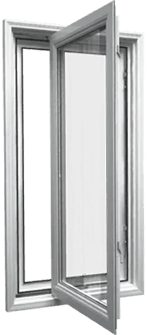
Definition: Casement windows swing open like a door, operating with a crank mechanism for full ventilation. These hinged windows open outward, creating a tight seal when closed.
Key Features: Energy efficient options with excellent air circulation capabilities. Casement windows provide superior ventilation and a tight seal against weather elements. Available with double or triple pane glass for enhanced energy efficiency and noise reduction.
Applications: Ideal for kitchens, bathrooms, and rooms requiring good ventilation. Perfect for locations where reaching to push up a window might be difficult. Popular in Canadian homes for their weather resistance.
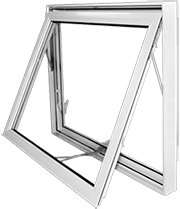
Definition: Awning windows are hinged at the top and open outward from the bottom, allowing for ventilation even during light rain. They create a protective awning when open.
Key Features: These operable windows provide excellent weather protection while allowing fresh air. Energy efficient with tight seals when closed. Available in various sizes with different glass panes options for improved insulation.
Applications: Commonly installed above fixed windows or in basements. Ideal for spaces requiring ventilation and light while maintaining privacy. Perfect for Canadian climates with frequent precipitation.
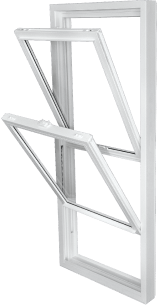
Definition: Double-hung windows feature two movable sashes that slide vertically. Both the top sash and bottom sash are operable, allowing for versatile ventilation control.
Key Features: Excellent for air flow management, as opening both sashes creates natural convection. Easy cleaning with tilt-in sash design. Energy efficient options available with double or triple pane glass for Canadian winters.
Applications: Versatile windows suitable for any room in the home. Traditional style that complements classic and modern architecture alike. Popular in bedrooms and living rooms across the Greater Toronto Area.

Definition: Single-hung windows have a fixed top sash with only the bottom sash that moves upward to open. This classic window style balances functionality with cost-effectiveness.
Key Features: Energy efficient design with fewer moving parts than double hung windows. Good air circulation with simplified operation. Lower maintenance requirements with a fixed upper section.
Applications: Well-suited for bedrooms, living rooms, and areas where simplified operation is preferred. Common in new construction and replacement window projects across Canada.
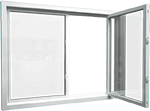
Definition: Sliding windows open horizontally along a track, with one fixed pane and one sliding sash. These large sliding windows maximize views with minimal space requirements.
Key Features: Space-efficient as they don’t project outward or inward. Smooth operation with durable rollers for ease of use. Energy efficient options with weatherstripping for superior insulation.
Applications: Perfect for rooms facing walkways, decks, or patios where projecting windows would be impractical. Ideal for wide, short spaces and areas with limited wall space.
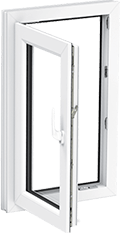
Definition: Tilt and turn windows offer dual functionality—they can tilt inward from the top for ventilation or swing inward like a door for full opening and easy cleaning.
Key Features: Superior energy efficiency with exceptional weather sealing. Versatile operation modes providing flexible ventilation options. Enhanced security features with multi-point locking systems.
Applications: Popular in European-inspired homes throughout Canada. Suitable for bedrooms and living areas where maximum ventilation and easy maintenance are desired.
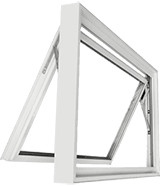
Definition: Hopper windows are hinged at the bottom and open inward from the top. This compact window type maximizes ventilation in small spaces.
Key Features: Energy efficient with tight seals when closed. Space-saving design ideal for smaller openings. Excellent security options as the inward opening allows for secure screen placement.
Applications: Primarily used in basements and bathrooms where space is limited but ventilation is needed. Also suitable for upper floors where outside access is difficult.
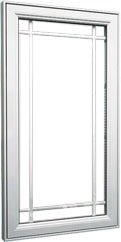
Definition: Fixed windows do not open, featuring stationary glass within a frame. These specialty windows prioritize light, views, and energy efficiency over ventilation.
Key Features: Maximum energy efficiency with no moving parts to cause air leaks. Available with various glass options including double and triple pane glass. Excellent for creating custom configurations with other operable windows.
Applications: Ideal for showcasing views, increasing natural light, or creating architectural interest. Often used in living rooms, stairwells, or alongside other windows types that provide ventilation.
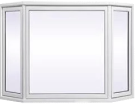
Definition: Bay windows project outward from a home, typically consisting of three windows—a fixed center window with two angled side windows that can be fixed or operable.
Key Features: Creates additional interior space and seating opportunities. Enhances curb appeal while providing panoramic views. Available with casement or double-hung windows on the sides for ventilation.
Applications: Statement feature in living rooms and dining rooms. Creates cozy nooks in bedrooms or reading areas. Adds architectural interest to both traditional and contemporary Canadian homes.

Definition: Bow windows consist of four or more windows arranged in a curved configuration that projects outward. They create a smoother arc than bay windows for a rounded appearance.
Key Features: Elegant curved design providing expansive views and abundant natural light. Can incorporate casement or fixed panes in various combinations. Creates a distinctive look while expanding interior space.
Applications: Makes a striking architectural statement in living rooms and master bedrooms. Perfect for maximizing views in Canadian homes with scenic surroundings.
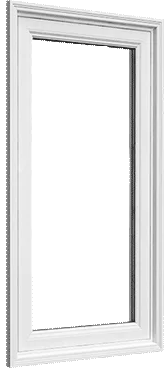
Definition: Picture windows are large fixed panes designed to frame exterior views like artwork. These specialty windows prioritize unobstructed visibility and light.
Key Features: Maximizes natural light and views with minimal frame interruption. Energy efficient with no operable parts to cause air leaks. Available in various shapes including arched windows and half-moon windows.
Applications: Ideal for living rooms with scenic views or anywhere that prioritizes light over ventilation. Often paired with operable windows to balance visibility with air circulation needs.
Definition: Bathroom windows balance ventilation, natural light, and privacy requirements. Options include frosted glass panes, high placement, or specialized shapes.
Key Features: Privacy glass options to prevent visibility while allowing light. Good ventilation capabilities to manage moisture and humidity. Compact designs for limited wall space in bathrooms.
Applications: Essential for moisture control in bathrooms across Canadian homes. Available in various styles including awning, casement, or glass block windows for different aesthetic preferences.
Definition: Windows in shower areas require specialized materials and treatments to withstand constant moisture exposure while maintaining privacy and light transmission.
Key Features: Waterproof construction with sealed frames and moisture-resistant window frame materials. Privacy glass options including frosted, textured, or glass blocks. Typically include vinyl or fiberglass frame materials for low maintenance.
Applications: Adds natural light to shower enclosures while enhancing ventilation. Usually positioned above eye level or with privacy glass for comfort and security.
Definition: Bedroom windows provide essential light, ventilation, and emergency egress. Popular options include double-hung, casement, and sliding styles.
Key Features: Designed for easy operation and cleaning from interior spaces. Energy efficient options for comfort during cold Canadian nights. Often include enhanced security features for peace of mind.
Applications: Must meet egress window requirements for safety in sleeping rooms. Styles chosen typically complement the home’s architecture while providing adequate light and air circulation.
Definition: Kitchen windows enhance functionality in this busy space, providing ventilation, light, and sometimes a garden window for plants or display items.
Key Features: Easy-to-clean surfaces that resist moisture and cooking residues. Operational styles that allow for ventilation even with limited wall space. Often include low-maintenance frame options.
Applications: Typically positioned near sinks or cooking areas to maximize natural light and ventilation. Available in styles that complement kitchen workflow and aesthetics.
Definition: Living room windows serve as focal points while providing abundant natural light and potentially stunning views of the outside world.
Key Features: Larger dimensions than other windows in the home. Often combine fixed panes with operable sections for ventilation. May include decorative elements for aesthetic enhancement.
Applications: Central feature in main gathering spaces across Canadian homes. Available in statement styles like bay, bow, or large picture windows to enhance interior brightness and spaciousness.
Definition: Attic windows transform upper spaces with natural light while potentially providing ventilation. Options include dormer windows, gable windows, or skylights.
Key Features: Specialized designs that work within sloped roof structures. Energy efficient options to prevent heat loss through upper portions of the home. Available in fixed or operable styles depending on needs.
Applications: Enhances usability of attic spaces as bedrooms, offices, or storage. Often installed during renovation projects to improve upper floor functionality in Canadian homes.
Definition: Home office windows balance productivity needs with comfort concerns through strategic placement, light control, and noise reduction features.
Key Features: Often incorporate low-glare glass options for computer screen visibility. Energy efficient designs to maintain comfortable working temperatures. May include noise-reducing glass for concentration.
Applications: Positioned to provide natural light without screen glare. Style choices depend on home architecture while prioritizing comfort for long working hours.
Definition: Dining room windows enhance mealtime experiences through natural light, views, and sometimes architectural interest with specialty window styles.
Key Features: Decorative options including grille patterns or transom windows for enhanced aesthetics. Positioned to highlight dining areas while maintaining privacy. May include bay or bow configurations for expanded space.
Applications: Creates a welcoming atmosphere for family gatherings and entertaining. Often designed to frame outdoor views or landscaping elements from the dining area.
Definition: Sunroom windows maximize light exposure while managing temperature control through energy efficient glass technologies and strategic placement.
Key Features: Extensive glazing with high-performance glass to prevent heat loss/gain. May include tinted options to reduce UV exposure and sun damage. Often feature multiple operable windows for cross-ventilation.
Applications: Creates bright, indoor-outdoor spaces for year-round enjoyment in Canadian homes. Window selection balances light exposure with climate control needs.
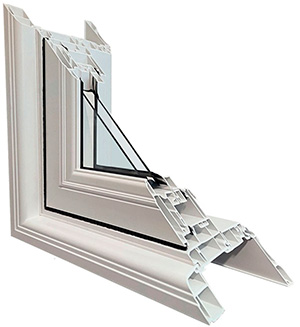
Definition: Vinyl windows feature frames made from PVC (polyvinyl chloride), offering exceptional durability and insulation. These low maintenance windows resist moisture, warping, and fading.
Key Features: Energy efficient with excellent thermal performance to combat Canadian winters. Available in various styles including casement, double hung, and sliding windows. Cost-effective option with long lifespan and minimal upkeep requirements.
Applications: Ideal for most Canadian homes in any climate zone. Popular choice for both new construction and replacement window projects due to versatility and value.
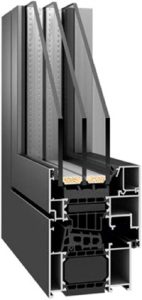
Definition: Aluminum windows feature lightweight yet strong metal frames that offer slim profiles and maximum glass area. These durable windows provide excellent structural integrity.
Key Features: Exceptional strength-to-weight ratio allowing for larger glass areas and narrower frames. Available in various colors and finishes for custom windows applications. Recyclable material choice for environmentally conscious homeowners.
Applications: Well-suited for modern architectural styles and commercial applications. Excellent for areas requiring strength against high winds or structural support for large window openings.

Definition: Wood windows feature natural timber frames that offer classic aesthetics and excellent insulation properties. These traditional windows provide timeless beauty and architectural authenticity.
Key Features: Superior natural insulation with excellent thermal performance. Offer warmth and classic aesthetics unmatched by other window types. Available in various wood species with custom stain or paint options.
Applications: Ideal for heritage homes, traditional architectural styles, and custom windows applications. Popular in high-end renovations where authentic materials and aesthetics are priorities.
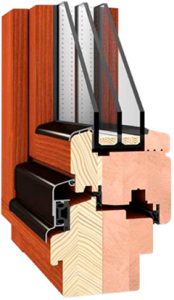
Definition: Wood-clad windows combine natural wood interiors with weather-resistant exterior cladding. These premium windows offer the best of both worlds—beauty inside and durability outside.
Key Features: Low maintenance aluminum or vinyl exterior protects against weather elements. Warm wood interior provides traditional aesthetics and excellent finish options. Available in various types of windows with custom sizing and configurations.
Applications: Perfect for upscale homes seeking traditional interior appearance with modern performance. Excellent choice for harsh Canadian climates where exterior durability is essential.
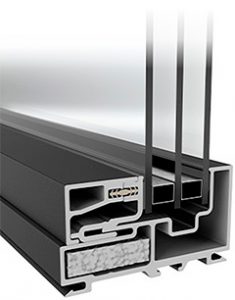
Definition: Fiberglass windows feature frames made from glass fiber reinforced polyester resins. These high-performance windows offer exceptional strength, durability, and dimensional stability.
Key Features: Excellent thermal performance with minimal expansion/contraction. Superior strength allowing for narrower frames and more glass area. Available in painted finishes that resist fading and chalking for decades.
Applications: Ideal for demanding environments and energy efficient windows applications. Perfect for modern architectural styles seeking clean lines and maximum glass. Excellent choice for all Canadian climate conditions.
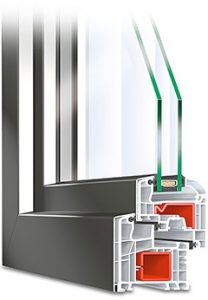
Definition: Composite windows utilize frames made from engineered materials combining wood fibers and thermoplastic polymers. These innovative windows offer superior performance with distinctive aesthetics.
Key Features: Exceptional insulation properties rivaling or exceeding wood windows. Enhanced resistance to rot, moisture, and insect damage. Available in various window styles with custom colors and finishes.
Applications: Well-suited for high-performance homes in any Canadian climate. Excellent alternative to traditional wood in demanding environments. Popular for custom windows projects seeking distinctive appearance.
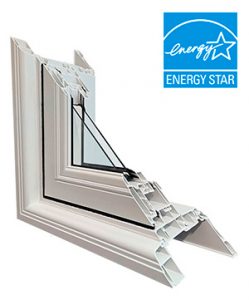
Definition: ENERGY STAR® certified windows meet strict energy efficiency guidelines established by Natural Resources Canada. These best windows exceed minimum performance standards.
Key Features: High-performance glass packages with superior insulation properties. Reduced heating and cooling costs through advanced thermal technologies. Often include low-E coatings and insulating gas fills like argon or krypton.
Applications: Suitable for any Canadian home wanting to improve comfort and reduce energy bills. Essential for meeting building code requirements in new construction across Canada.
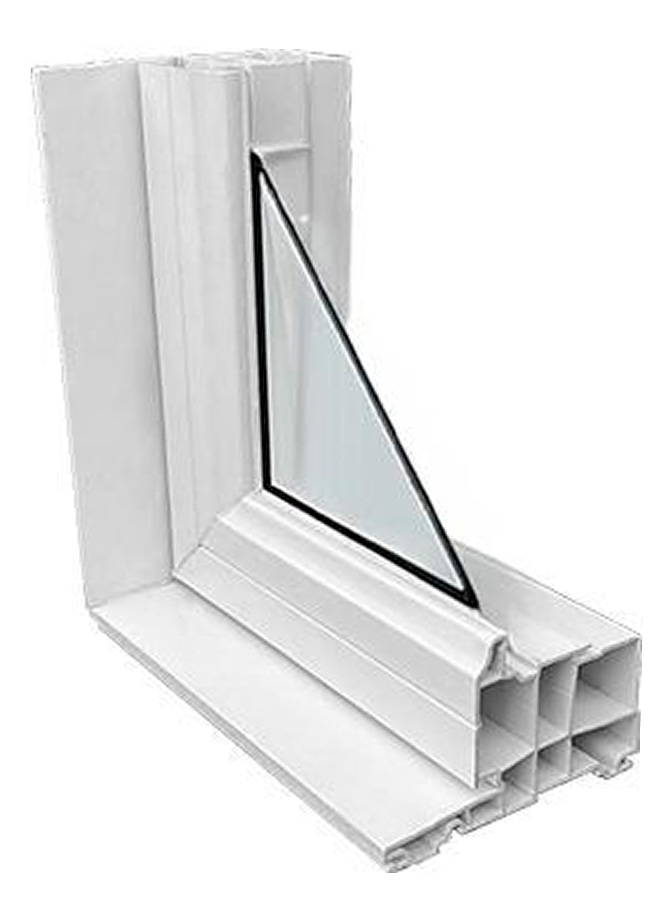
Definition: Single pane windows consist of a lone glass sheet within a frame. This basic window type represents older technology still found in some historic buildings.
Key Features: Simplest window construction with minimal materials. Lower initial cost than energy efficient windows but less performance. May offer authentic appearance for heritage restoration projects.
Applications: Primarily used for non-heated spaces like sheds or garages. Sometimes maintained in historic buildings with strict preservation requirements. Often replaced with better performing options in Canadian homes.
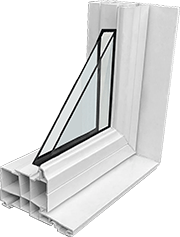
Definition: Double-pane windows contain two glass panes separated by an insulating spacer and gas fill. This standard for new windows balances performance with cost-effectiveness.
Key Features: Significantly better insulation than single pane windows. Available with various glass types and coatings for customized performance. Standard energy efficient option for most Canadian homes.
Applications: Versatile choice suitable for most rooms and climate zones. Popular replacement window option offering good value and performance upgrade from older windows.
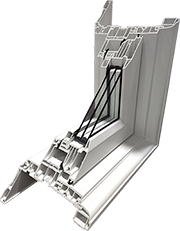
Definition: Triple-pane windows feature three layers of glass with insulating gas fills between each pane. These premium windows offer superior thermal and acoustic performance.
Key Features: Maximum energy efficiency with two insulating chambers instead of one. Exceptional noise reduction for quieter interior spaces. Reduced condensation even in extreme Canadian winter conditions.
Applications: Ideal for homes in severe climate regions or near noise sources like busy streets. Perfect for north-facing exposures and areas seeking maximum comfort and efficiency.
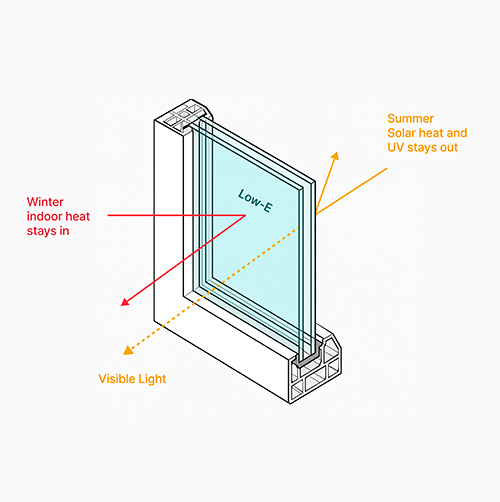
Definition: Low-E (low emissivity) coated windows feature microscopic metal or metallic oxide layers that reflect infrared light while allowing visible light to pass through.
Key Features: Blocks harmful UV rays that can fade furnishings and finishes. Reflects summer heat outward and winter heat inward for year-round efficiency. Available in various performance levels for different facing directions.
Applications: Essential technology for energy efficient windows throughout Canadian homes. Particularly valuable for large window areas and south-facing exposures.
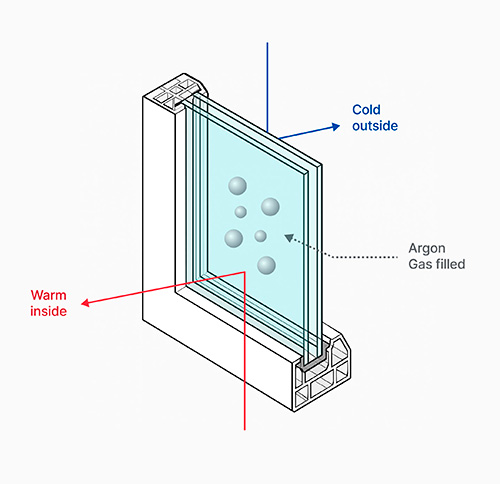
Definition: Argon gas-filled windows feature this odorless, colorless, non-toxic gas injected between glass panes to improve thermal performance compared to air.
Key Features: Better insulation than air-filled units with minimal cost increase. Reduces heat transfer through the window while improving soundproofing. Compatible with most types of windows and frame materials.
Applications: Standard in many energy efficient windows throughout Canada. Practical choice for balancing performance and value in most climate zones.
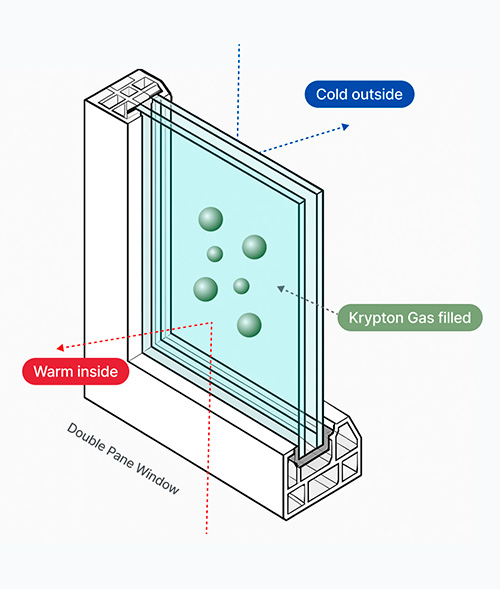
Definition: Krypton gas-filled windows contain this premium inert gas between panes, offering superior insulation properties compared to argon, especially in narrower spaces.
Key Features: Maximum thermal performance in thinner glass packages. Often used in triple pane glass systems for ultimate efficiency. Denser than argon for better insulation in extreme climates.
Applications: Ideal for high-performance windows in severe Canadian winter regions. Premium option for homeowners seeking the best possible energy performance.
Definition: Traditional windows feature classic designs that complement heritage homes and conventional architectural styles. These windows emphasize historical accuracy and timeless appeal.
Key Features: Often include divided lites or grille patterns that reflect historical periods. Typically feature double hung or casement operation with decorative elements. Available with modern performance features while maintaining traditional aesthetics.
Applications: Perfect for heritage homes, colonial, Georgian, or Victorian architecture. Suitable for neighborhoods with historical design guidelines across Canada.
Definition: Modern windows showcase clean lines, minimal framing, and maximum glass areas. These contemporary designs emphasize simplicity, function, and indoor-outdoor connection.
Key Features: Streamlined frames with minimal visual obstructions. Often feature large fixed panes combined with sleek operating windows. Emphasize energy efficiency with advanced glass technologies.
Applications: Ideal for contemporary architectural styles and renovations. Perfect for maximizing views and natural light in urban and suburban Canadian homes.
Definition: Colonial windows feature distinctive divided lite patterns, typically with six or nine panes per sash. These traditional designs evoke early North American architectural heritage.
Key Features: Classic grid patterns with true or simulated divided lites. Often feature double hung sash windows operation for authentic period styling. Can include decorative elements like arched tops or special grille configurations.
Applications: Perfect match for Colonial, Cape Cod, or Federal style homes. Popular in traditional neighborhoods and heritage renovations across Canada.
Definition: Prairie style windows feature distinctive grid patterns with emphasis on horizontal lines. Inspired by Frank Lloyd Wright’s designs, these windows complement Arts and Crafts architecture.
Key Features: Characteristic grille patterns with bars at upper corners and edges only. Emphasize horizontal lines and earthbound aesthetic. Often feature casement operation for clean sight lines.
Applications: Ideal for Prairie, Craftsman, or Mission style homes. Adds architectural authenticity to bungalows and early 20th century inspired designs.
Definition: Art Deco windows showcase geometric patterns, bold lines, and decorative elements that reflect this distinctive early 20th century design movement.
Key Features: Geometric grille patterns with zigzags, sunbursts, or stepped designs. May incorporate decorative glass or metallic accents. Combines modern efficiency with period-appropriate aesthetics.
Applications: Perfect for Art Deco, Streamline Moderne, or 1920s-1930s homes. Creates distinctive character in boutique properties or heritage buildings in urban centers.
Definition: Craftsman style windows feature multiple panes in the upper sash with a single pane below. These windows complement the handcrafted aesthetic of Arts and Crafts architecture.
Key Features: Distinctive divided lite pattern typically with 4-6 panes above and single pane below. Often feature casement or double hung operation with authentic hardware. Emphasize natural materials and traditional craftsmanship.
Applications: Ideal for Craftsman bungalows, Four-square, and Arts & Crafts inspired homes. Popular in established neighborhoods throughout the Greater Toronto Area.
Definition: Jalousie windows feature multiple horizontal glass slats that open and close simultaneously via a crank mechanism. These specialty windows maximize ventilation while providing shade.
Key Features: Full-width ventilation when open with adjustable airflow control. Cost-effective option compared to other types of windows. Provides excellent cross-breeze in moderate climates while maintaining some protection from rain.
Applications: Ideal for sunrooms, porches, and seasonal spaces. Popular in milder Canadian regions for three-season rooms. Often used in combination with other window styles for varied performance.
Definition: Windows designed for hot climates prioritize solar heat rejection while maintaining visibility and light transmission. These specialized windows help reduce cooling costs.
Key Features: Low Solar Heat Gain Coefficient (SHGC) to block unwanted heat. Special tints or reflective coatings to reduce summer heat gain. Often feature low-E coatings calibrated for cooling-dominated climates.
Applications: Beneficial for south and west-facing exposures even in Canadian homes. Ideal for sunrooms, conservatories, and spaces with large glass areas. Important for maintaining comfort in increasingly warm Canadian summers.
Definition: Cold climate windows are engineered to retain interior heat while maximizing passive solar gain. These energy efficient windows excel in Canadian winter conditions.
Key Features: High insulation values with U-factors below 0.30. Often feature triple pane glass with multiple low-E coatings. Designed to reduce condensation even in extreme temperature differentials.
Applications: Essential for homes throughout the Greater Toronto Area and colder Canadian regions. Particularly important for north-facing exposures and areas with significant winter winds.
Definition: Coastal windows feature corrosion-resistant materials and specialized finishes to withstand salt spray and high humidity. These durable windows maintain performance in harsh marine environments.
Key Features: Corrosion-resistant frame materials like vinyl or specially treated aluminum. Hardware made from stainless steel or other non-corrosive metals. Enhanced seals to prevent moisture intrusion from driving rain.
Applications: Essential for lakefront properties around the Great Lakes. Important for homes near salt-treated roadways in urban areas. Provides long-term durability in high-moisture environments.
Definition: Hurricane-resistant windows incorporate impact-resistant glass and reinforced framing to withstand extreme wind and flying debris. These safety windows protect home interiors during severe weather.
Key Features: Laminated or tempered glass that remains intact when shattered. Reinforced frames with enhanced anchoring to the building structure. Tested to meet strict performance standards for wind pressure and impact.
Applications: Valuable for Canadian coastal regions and areas prone to extreme weather events. Provides year-round protection against break-ins and accidents. Often required by insurance companies in certain regions.
Definition: Storm windows are secondary windows installed outside or inside existing windows. These supplemental windows improve insulation and weather protection with minimal disruption.
Key Features: Cost-effective way to improve performance of existing windows. Can be seasonal (removable) or permanent installations. Reduces drafts, noise, and condensation on primary windows.
Applications: Excellent option for heritage homes where replacing original windows isn’t desired. Temporary solution before full window replacement in Canadian homes. Popular for improving rental property efficiency with minimal investment.
Definition: Security windows feature reinforced glass, specialized locks, and strengthened frames to deter break-ins. These protective windows maintain appearance while enhancing home safety.
Key Features: Laminated or tempered glass that resists breaking or creates noise when broken. Multi-point locking systems that secure the sash at multiple locations. Often include limiting devices to prevent full opening when desired.
Applications: Important for ground-floor windows and other accessible entry points. Valuable in urban areas and properties that may be unoccupied seasonally. Available in all window styles for consistent home aesthetics.
Definition: Soundproof windows utilize multiple strategies to reduce noise transmission, including specialized glass, optimal spacing, and insulated frames. These acoustic windows significantly reduce external noise.
Key Features: Laminated glass with noise-dampening interlayer that disrupts sound waves. Different glass thicknesses to prevent resonant vibration. Maximum air space between panes for superior sound attenuation.
Applications: Essential for homes near highways, railways, or flight paths. Valuable for bedrooms, home offices, and media rooms. Creates quieter interior spaces throughout busy GTA neighborhoods.
Definition: Fire-resistant windows incorporate specialized glass and framing designed to maintain their integrity during fires. These safety windows help prevent flame spread between building areas.
Key Features: Tested to maintain integrity for specific time periods during fire exposure. May use ceramic glass, laminated fire-resistant glass, or intumescent layers. Frames constructed of fire-resistant materials that won’t contribute to combustion.
Applications: Often required by building codes for windows near property lines. Important for multi-unit buildings and attached homes. Provides additional evacuation time during emergencies.
Definition: Egress windows meet specific size and accessibility requirements to serve as emergency exits. These code-compliant windows are essential for legal basement bedrooms in Canadian homes.
Key Features: Minimum opening size requirements (typically 3.8 sq ft opening with minimum dimensions). Easy operation from the inside without special tools or knowledge. Often installed with window wells to provide clear exit path from below-grade spaces.
Applications: Mandatory for basement bedrooms throughout Canada. Important safety feature for any sleeping areas. Often installed during basement renovations to meet building codes.
Definition: Smart windows incorporate technological features that enhance convenience, security, and energy efficiency. These advanced windows represent the cutting edge of window innovation.
Key Features: May include built-in sensors for security or climate monitoring. Some versions feature automated opening/closing systems. Advanced models incorporate electrochromic glass that can tint electronically.
Applications: Perfect for tech-forward homes with integrated smart systems. Beneficial for difficult-to-reach windows that benefit from remote operation. Adds convenience and efficiency to modern Canadian homes.
Definition: Self-cleaning windows feature specialized coatings that break down dirt which then washes away during rainfall. This low-maintenance technology reduces the need for exterior window cleaning.
Key Features: Photocatalytic coating that uses sunlight to break down organic materials. Hydrophilic surface that sheets water evenly to rinse away loosened dirt. Works continuously but is most effective on regularly rained-upon surfaces.
Applications: Valuable for difficult-to-access windows on upper floors. Popular for large glass areas that are challenging to clean manually. Provides labor-saving benefits for busy Toronto homeowners.
Definition and Basic Function: Clerestory windows are narrow windows positioned high on a wall, typically near or at ceiling level. They allow natural light to enter a space while maintaining privacy.
Key Features: These windows maximize daylight penetration deep into a room’s interior without compromising privacy. They reduce the need for artificial lighting during daylight hours and can be fixed or operable for ventilation, creating a stack effect that helps release hot air.
Applications: Ideal for bathrooms, living rooms with high ceilings, and modern open-concept spaces. They work exceptionally well in homes with northern exposures or where neighboring buildings block light at conventional window heights.
Definition and Basic Function: Transom windows are horizontal windows positioned above doors or other windows. They allow additional light and ventilation while adding architectural interest to entryways and interior passages.
Key Features: Available in fixed or operable styles, these windows improve natural light distribution and airflow. They often feature decorative glass patterns that add character while maintaining privacy and can be integrated into both traditional and contemporary designs.
Applications: Commonly used above entry doors, in hallways, and between rooms in heritage homes. They’re excellent for creating visual separation between spaces while allowing light to flow through connected areas.
Definition and Basic Function: Basement windows provide light and ventilation to below-grade spaces. They are designed to resist moisture infiltration and often include egress options for safety compliance.
Key Features: Available as hopper, sliding, or egress-compliant styles, they feature reinforced frames and specialized drainage systems. Modern versions offer enhanced security features and energy-efficient glass options to minimize heat loss in these typically cooler spaces.
Applications: Essential for finished basements, home offices, and basement apartments. Installation typically requires a window well and proper drainage to prevent water accumulation against the glass.
Definition and Basic Function: Dormer windows project vertically from a sloped roof, creating additional headroom and light in attic or upper-floor spaces. They extend the usable area of rooms with slanted ceilings.
Key Features: These architectural elements add character to a home’s exterior while dramatically increasing natural light. They create alcoves inside that can serve as reading nooks or display areas and improve cross-ventilation in upper stories.
Applications: Perfect for converted attics, loft spaces, and upper-floor bedrooms. They work particularly well in Cape Cod, Tudor, and Colonial-style homes to maximize usable space under the roofline.
Definition and Basic Function: Gable windows are installed in the triangular portion of a wall beneath the end of a pitched roof. They provide light to attic spaces and enhance a home’s architectural symmetry.
Key Features: Available in various geometric shapes that complement roof pitches, they add distinctive character to building facades. These windows can be fixed or operable and often include special insulation details to prevent heat loss at roof junctions.
Applications: Primarily used in attic spaces, bonus rooms, and homes with cathedral ceilings. They’re particularly effective in homes with east/west orientations to capture morning and evening light.
Definition and Basic Function: Corner windows meet at a 90-degree angle, eliminating the need for a structural corner post. They create panoramic views and bring exceptional light into rooms from multiple directions.
Key Features: These architectural statements maximize views and create a sense of openness. They use specialized structural support systems to maintain building integrity without visible corner posts and often include high-performance glass to manage solar gain.
Applications: Ideal for living rooms, dining areas, and modern architectural designs. They work especially well in homes with scenic views and can transform ordinary rooms into dramatic spaces with strong indoor-outdoor connections.
Definition and Basic Function: Garden windows project outward from the house, creating a mini-greenhouse effect with glass on three sides and top. They provide an ideal growing environment for herbs and small plants.
Key Features: With built-in shelving and advanced sealing to prevent moisture issues, these windows create a microclimate for plants. They include operable side vents for temperature control and typically feature tempered glass for safety and durability.
Applications: Most commonly installed in kitchens above sinks, but also work well in sunny bathrooms and breakfast nooks. They require proper flashing and weatherproofing during installation to prevent leaks.
Definition and Basic Function: Sidelight windows are narrow vertical windows positioned alongside entry doors. They frame entryways while allowing natural light into foyers and improving visibility of visitors.
Key Features: Available with clear, frosted, or decorative glass options for various privacy levels, these windows enhance curb appeal and entry aesthetics. They can be fixed or operable and often include multi-point locking systems for added security.
Applications: Essential elements for front entrances in both traditional and contemporary homes. They’re particularly valuable in homes with dark entryways or where the front door faces north with limited direct sunlight.
Definition and Basic Function: Storefront windows are large, commercial-grade display windows designed for retail and business facades. They maximize visibility of interior spaces while providing security and thermal performance.
Key Features: Constructed with aluminum framing and tempered or laminated safety glass, these windows offer exceptional durability and low maintenance. They can incorporate tinting, low-E coatings, and security features while maintaining maximum transparency.
Applications: Primarily used in commercial buildings, retail spaces, and mixed-use properties. They’re increasingly popular in modern homes with industrial aesthetics, particularly for ground-floor spaces facing urban streets.
Definition and Basic Function: Cellar windows are small, often rectangular windows that provide minimal light and ventilation to unfinished basement areas. They’re designed for utility and basic code compliance rather than aesthetics.
Key Features: Typically featuring simplified opening mechanisms like hoppers or awnings, these windows prioritize functionality and security. Modern versions include corrosion-resistant frames, improved weather sealing, and optional security grilles.
Applications: Used in unfinished basements, storage areas, and utility spaces. They’re often installed at ground level with protective wells and drainage systems to prevent water infiltration during heavy rainfall.
Contact us today to learn more about our replacement window options and receive a free consultation for your next home improvement project.
By submitting this form you agree to our Terms and Conditions